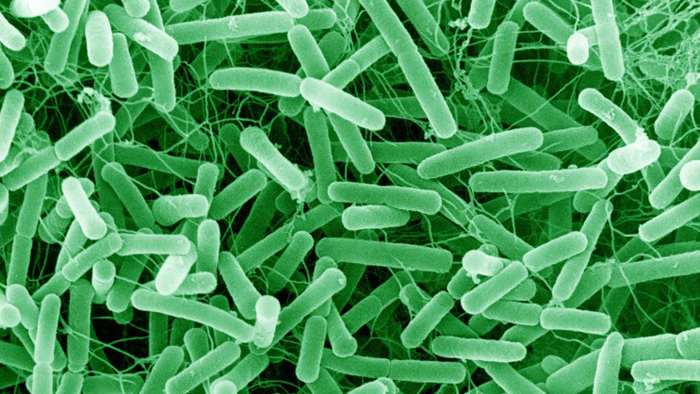News
Functional Metagenomics Enables First Study of Bacterial Fitness in the Gut Microbiome

Photo by David Gregory and Debbie Marshall, Wellcome Images.
Recent deep sequencing studies are providing an increasingly detailed picture of the genetic composition of the human microbiome, the diverse collection of bacterial species that inhabit the gut. At the same time, however, little is known about the dynamics of these colonies, particularly why certain microbial strains outcompete others in the same environment. In a new paper published in the journal Molecular Systems Biology, Department of Systems Biology Assistant Professor Harris Wang, in collaboration with Georg Gerber and researchers at Harvard University, report on their development of the first method for using functional metagenomics to identify genes within commensal bacterial genomes that give them an evolutionary fitness advantage.
In the initial test of their approach, called Temporal Functional Metagenomics Sequencing (TFUMseq), they took fragments from the genome of the bacteria Bacterioides thetaiotaomicron (Bt) and inserted them into E. coli bacteria. They then gave food containing these engineered E. coli to mice bred to have no bacteria in their gut. This provided a kind of sterile, blank slate for the new bacterial colony to grow. The team then extracted bacteria from the mice’s feces at multiple time points across a span of 28 days. For each sample, they sequenced the bacteria and looked for the relative abundance of bacteria containing each of the Bt gene fragments. They then used a new computational analytic approach based on information theory to analyze these measurements and provide an index of which fragments conferred the greatest selection advantages. Because measurements were taken at multiple time points, they also showed how the competitive environment within the gut changed over time, enabling them to make accurate hypotheses of the underlying molecular activity.
Bacterioides thetaiotaomicron is a very common component of the microbiome that grows reasonably well in a laboratory setting. However, many other bacteria that grow in the gut do not, making them extremely difficult to study. Combining functional genomics, deep sequencing, and computational methods in this way, the authors posit, offers a powerful new tool for doing so. In the experiments described in the paper they discovered several previously unknown details about the genes that enable Bt to multiply in the gut, including nutrient sources that are critical for Bt metabolism and enable the microbe to thrive.
The knowledge that their approach generates, the researchers anticipate, could offer strategies for engineering probiotic bacteria that retain a fitness advantage after being ingested, enabling them to persist in the gut longer and to be used more effectively to deliver other beneficial gene products. The authors also suggest that their approach could help to engineer bacteria to have a fitness advantage in the same niche as known pathogens. In this way, the engineered bacteria would outcompete the pathogens for available sources of energy and reduce their deleterious effects.
In a “News & Views” review that appears in Molecular Systems Biology along with the paper, Jeremiah Faith discusses the potential implications of the method:
The framework presented by Yaung et al for understanding the functional capacity of gut microbes drives to the heart of the most fundamental requirement of any organism in the microbiome, namely its ability to stably colonize a host in the context of the rich genetic diversity of competing organisms and host factors… [I]dentifying the genetic elements that confer fitness advantages during colonization is essential for understanding the final assembly of each individual’s microbiota. Advantages of TFUMseq compared to existing technologies include its simplicity and, more importantly, its potential to be applied to forward engineer bacterial strains with enhanced colonization abilities in defined contexts, such as specific dietary interventions.
In the future, Wang says, the researchers plan to test their method in mice that already have an existing microbiota, instead of being germ-free. By studying how different microbiota change the competitive profile of different bacterial genes, they anticipate being able to learn more about factors that improve competition, as well as about the composition of the different gut environments themselves.
— Chris Williams
Related publication
Yaung SJ, Deng L, Li N, Braff JL, Church GM, Bry L, Wang HH*, Gerber GK*. Improving microbial fitness in the mammalian gut by in vivo temporal functional metagenomics. Mol Sys Bio 2015 Mar 11;11(3):788.
* indicates equal author contributions